|
The Impact of Emiratisation on Job
Description Issues

Asma Omar Alabdelkarim (1)
May Khamis Muftah (1)
Sasha Hodgson (2)
(1) Graduate Students of Management,
Zayed University
(2) Assistant Professor of Management,
Zayed University
Correspondence:
Sasha Hodgson
Assistant Professor of Management,
Zayed University
P.O. Box 144534
Abu Dhabi
United Arab Emirates
Email: Sasha.Hodgson@zu.ac.ae

Abstract
Job description plays a key role when
hiring or applying for any job at
any organization. It details the job
to be performed, and roles and responsibilities
involved clearly so as to clarify
the applicant with his work. There
are many associated issues with job
description in the current industrialised
world as employees who are not very
well clear of their job description
are just made to perform any task
that is highly critical. This activity
is leading to major failures and losses
in the business to lack of expertise
of the work force deployed for performing
the action. All these related issues
are caused due to various factors
including Governments quota, policies
to allow few employees without proper
qualifications or skills, leading
to job dissatisfaction, stressful
work environment and many other issues.
This study aims at studying such job
description related issues, factors
causing such issues and their significance
along with statistical hypothesis
testing. It also aims at studying
various measures adopted by the UAE
government and private organizations
to overcome such job description related
issues. Further discussion on the
research is found in the sections
below in detail.
Keywords: Job
Description, Emiritisation, Hypothesis
testing, Job dissatisfaction, Ghost
employees

1. Introduction
Job description can be defined as
the duties and the responsibilities
that an employee needs to carry out
when employed in an organisation.
All organisations should clearly define
the job role so that the employee
knows what he/she is supposed to do
and what he/she is accountable for.
The Job description helps employees
know what an organisation expects
them to do and how they should go
about achieving that expectation.
The greater the clarity of job role,
the better is the coordination between
employees and organisation and lesser
the disputes. The various advantages
of clear job description are as follows:
(Sims, 2007)
• It helps to coordinate an organization's
vision and mission with the employees'
responsibilities and accountability
• It helps the recruiting department
to adopt strategies so that applicants
clearly know their duties and responsibilities
before joining the company
• It helps the recruiting department
to devise interviews based on job
description so that the right candidate
for the particular job gets recruited.
• It helps an organization to
figure out what type of training should
be given to the candidate so that
his/her efficiency increases which
in turn increases efficiency of the
organization. Proper training also
helps in overall development of the
employee.
• It helps an organization to
determine the proper remuneration
according to the degree of responsibilities
and accountability.
• It helps in performance management
because clear job description makes
employees understand what is expected
and what they are supposed to do.
• It reduces the disputes between
organization and employees thereby
increasing the productivity of an
organization.
Thus we can see that presence of good
job description has many advantages
for the individuals as well as the
organisations. (Amos, Ristow, Pearse,
& Ristow, 2009)
The UAE labour market consists of
expatriates and UAE nationals. In
2010, in private sector companies
in UAE only 7% of employees are Emirati
while the remaining 93% are expatriates.
(Thompson, 2011) So in order to lessen
this difference the UAE government
brought in the Emiratisation policy.
It's the strategy that the UAE government
has adopted to increase the participation
of UAE nationals or the local workforce
in the private sector companies. According
to which all private sector companies
should reserve at least 15% of jobs
for the UAE nationals. This has led
various private companies to create
non-jobs for UAE nationals. Non jobs
are the jobs where there are no responsibilities
while the employees earn easy salaries.
(How can Emiratisation affect your
business?) However such non jobs can
affect the performance of the hard
working foreign employees or expats
in the organisation and affect their
performance and they may also resign.
Also most of the UAE youths want to
join the government sector organisation
after graduation (Almazroui, 2013)
as government companies offer more
salaries and perks as compared to
private sector companies. Also the
working hours in government companies
are less compared to private companies.
The major obstacles that the UAE government
is facing are as follows:
• UAE nationals lack the skill,
motivation and the expertise that
is required for working in a private
company. (Randhawa, 2007)
• UAE nationals have unrealistic
expectation of salaries and perks
which private sector companies cannot
afford.
• Also there is large difference
between salaries in government and
private sector companies so local
workforce prefer government companies
over private sector companies. (Price,
2011)
1.1. Research Objective
The objective of this research is
to study the job description issues
in the various organisations in UAE
and find out the factors responsible
for them. Also our objective is to
find out whether the Emiratisation
policy that the government has developed
for the benefit of the UAE nationals
is in any way linked to the job description
issue in most of the organisations
in UAE. In this research we will also
determine how the issues of job description
can be handled by the organization
in an effective way. In this research
we will be discussing the joint initiatives
that the government and private organisations
can take to implement the Emiratisation
effectively. It will also help government
identify what it should do to make
UAE nationals as competitive as the
foreign expats and increase their
presence in the private sector companies.
It will also help in evaluating the
government approach for the development
local workforce. Also the purpose
of the study is to recommend to companies
how they can solve issues related
to job description. (Randhawa, 2007)
1.2. Research Question
• What are the factors which
lead to job description issues in
most of the organizations in UAE?
Is Emiratisation one of them?
• What government should do to
implement Emiratisation effectively
in the organization without affecting
efficiency of the organization?
• What steps can be taken by
organizations in the UAE to manage
job description issues?
• How government and private
sector companies can come together
to solve the issue of unemployment
in UAE? (Gary, 2011)
1.3. Hypothesis
• The Emiratisation policy of
government which enforces organisations
to hire a certain quota of UAE nationals
is one of the main reasons behind
the job description issues in most
of the organizations.
• People get hired even when
their qualifications and skills are
not matched to the job description.
• The Emiratisation policy of
government is leading to job-dissatisfaction
and stressful work environment.
• Job description issues affect
motivation of employees.
1.4. Project Outcome
The result or the outcome of the research
will be helpful for the companies
to learn the impact of Emiratisation
on the job description issues in UAE
and various other factors that lead
to the job description issue. Also
it will help companies to know what
steps they could take to reduce these
problems and help them formulate policies
accordingly. It will help government
to review its policies regarding Emiratisation
and make changes accordingly. Also
recommendations will be for government
to develop its work force effectively
for the future. Also it will help
researchers in their future research
work.
2. Literature
Review
The United Arab Emirates has employees
working in different sectors from
different countries. Every one performs
their roles and duties and abide the
organizational norms. Job description
is what clarifies the employees about
their roles and duties. The classification
of employees working in the UAE is
as depicted below, as obtained from
the statistic bureau of Dubai as on
2008.
The data clearly depicts the distribution
of employees, working in different
sectors, from different nations. The
different services include legislators,
senior officials, managers, professionals,
technicians, clerks, service workers,
market sales man, skilled agricultural
and fishery workers, craft and trades
man, P & M operators, Assemblers,
Elementary occupations.

(Khan, 2012)
2.1 Impact of Emiratisation on
Job Description Issues
Emiratisation is the policy that the
government of the UAE has adopted
to increase the UAE nationals in the
private sector industries. The Government
has been pursuing this policy for
a long time but it has not been able
to find success. According to an official
report, in 2009-10 UAE nationals accounted
for less than 1% of its private sectors
workers. (Khan, 2012) According to
government rule at least 15% of employees
in private sector must be UAE nationals.
Also the government has devised the
policy to impose fines on the companies
which do not follow this rule. Also
it has imposed fines Dh 20000 on companies
who have 'ghost employees'. (Shaheen,
2010) The ghost employees are those
UAE nationals who receive the payment
but they don't work in the company.
(Salem, Firms face big fines for 'ghost
emiratisation', 2010) These UAE nationals
didn't have any job description. They
were just hired and no work was allotted
to them. This shows they were given
money without doing any work. The
companies employ them so that they
can abide by the rule of UAE government.
The government policy regarding ghost
workers shows that companies were
involved in such type of activities.
Thus we can see that Emiratisation
resulted in job description issues
in private organisations. The private
companies did not have any clear job
description for the UAE nationals
that they employed in order to abide
by government law. They were considered
as additional expenditure by the companies.
The UAE nationals were considered
as an obstacle by private companies.
Thus we can see that Emiratisation
was the main reason behind the job
description issues in private organisations
in UAE. These job description issues
may also affect the expatriates working
in the company as it would lead to
their dissatisfaction and frustration.
This may lead to a decrease in the
productivity of their employees and
the organisation as whole. The improper
job clarity also leads to disputes
between the organisation and the employees.
So the organisation must clearly specify
the job description. A clear job description
helps employees know what is expected
of them and how they are supposed
to carry out the job. It also helps
HR in hiring the right person for
the job. It helps an organization
to figure out what type of training
should be given to the candidate so
that his/her efficiency increases
which in turn increases efficiency
of the organization. Proper training
also helps in overall development
of the employee and thereby his/her
satisfaction. It helps an organization
to determine the proper remuneration
and rewards according to the degree
of responsibilities and accountability.
It helps in alienating an organization's
vision and mission with the employees'
responsibilities and duties. It also
helps a company in retaining its best
employees and attracting new employees.
Thus job description is something
that a company should not take lightly
and care should be taken to make proper
job description so that there is no
conflict of interest. (Khan, 2012)
2.2 Private sector and government
view on Emiratisation
The private sector considers UAE nationals
as less productive, less motivated,
and unprofessional as compared to
expatriates. Also private companies
believe that UAE nationals don't have
the skills that are required to work
and their English language proficiency
is not good. This is the general belief
that is associated with the UAE national.
There is large difference in working
hours and remuneration level between
private sector companies and government
companies. The UAE nationals therefore
are more interested in doing government
jobs as there are more benefits associated
with a government job as compared
to private sector jobs. (Emirati graduates
choose government over private sector
jobs, 2013) The private sector considers
UAE nationals as a liability as they
have to pay higher salaries to them
as compared to expatriates. So the
private sector considers Emiratisation
policy as a liability.
According to government, private companies
hire employees but they don't treat
them well as a result of which they
get frustrated and leave the job.
Government is firm on its decision
to implement Emiratisation. It's on
the top of its agenda. (Salem, FNC
advocates Emiratisation quotas for
the private sector, 2013).
Thus there is conflict of views regarding
Emiratisation between the private
sector companies and the government.
For government to implement Emiratisation
it has to work in coordination with
private sector companies. The government
and the private sector companies should
iron out their differences and make
a joint effort to implement Emiratisation.
The Government are taking various
steps to make the working environment
similar in the private and the public
sector organization. Also government
is planning to reduce the salary difference
that exists between private and the
public sector employees through government
subsidies to the private companies.
All these steps are being taken by
government to make the private sector
attractive for the UAE nationals.
Also government has mentioned the
minimum wages that can be given to
the local workers in its rule that
private companies have to follow.
Also private companies are made to
follow various other rules for the
benefit of UAE nationals. Also government
has concentrated on developing skills
of UAE nationals by focusing on the
education systems. It should give
vocational training to its nationals
so that they are job ready. Also the
UAE government helps the youth who
are interested in self employment
by funding their projects. Thus UAE
government supports self employment.
(Salem, FNC advocates Emiratisation
quotas for the private sector, 2013)
But for Emiratisation to be successful,
government effort alone will not be
sufficient. The private sector should
also honestly put in an effort to
implement the Emiratisation. It should
provide training programmes to UAE
nationals so that they can adjust
to the working culture in the private
organisation. The private companies
have to change their outlook. They
should also provide proper job description
to the UAE nations so that applicants
know what they are supposed to do.
Also government should come out with
strict rules that the private sector
has to abide by and the fine should
be high. (Salem, FNC advocates Emiratisation
quotas for the private sector, 2013)
2.3 Government failure to implement
Emiratisation
The idea of Emiratisation dates back
to the 1990's. However, initially
government was lax at implementing
Emiratisation. It was after 2004 that
the government became serious and
Emiratisation became the top priority
because the unemployment rate was
increasing among nationals and the
number for nationals in private sectors
was very low. This failure of the
Emiratisation added to the stereotyping
of nationals as less productive, less
efficient and unmotivated. The nationals
themselves as well as expatriates
started believing that they are incompetent,
lowering their self esteem (Al-Waqfi
& Forstenlechner, 2010). However
Government was to some extent successful
in implementing Emiratisation in the
banking and insurance sector but the
target could not be achieved (Baik,
2010)
3. The Research Methodology
The research is supported with the
help of quantitative methodology which
is done as per the following steps:
• As a part of the first step,
secondary data from various journals,
articles, research works and websites
have been collected and analysed to
frame the objectives and identify
the factors that show some significant
impact on the job description issues.
This data collection is discussed
in detail in the literature review
section. This is accomplished by studying
various articles, journal and the
previous research related to our study
and drawing a conclusion.
• The second step of the research
which plays the key role in the research
study is the primary data collection.
This is done with the help of a questionnaire
study by preparing an online questionnaire
which was circulated across various
organizations and their responses
were recorded. The details of questionnaire
are attached in the appendix. The
questions are framed such that the
responses are recorded on a Likert
scale varying from 1 to 5 corresponding
to strongly disagree, disagree, neutral,
agree and strongly agree.
There are total 11 questions that
are framed and each of the questions
corresponds to a specific factor to
analyse the impact on Job description
issues. Along with the questionnaire,
demographic parameters including Nationality,
gender and age group were also collected
through the response sheet. The data
sheet is attached in Excel format.
MS Excel was used as a tool to perform
the hypothesis testing which is explained
in the next section in detail.
HYPOTHESIS TESTING
Hypothesis testing is one of the statistical
methods used to measure the significant
relationship between two variables.
It is assumed on the basis of two
hypotheses, Null Hypothesis (H0) and
Alternative Hypothesis (H1).
H0: this hypothesis assumes
that there is no significant impact
of variable 2 on variable 1
H1: this hypothesis assumes
that there is significant impact of
variable 2 on variable 1
The acceptance and rejection of null
hypothesis is based on t-statistic
or p-value. If the t-statistic value
calculated is in the range of critical
values at assumed significance level,
the null hypothesis is accepted or
else it is rejected.
Similarly, if the p-value is less
than the significance level then the
null hypothesis is rejected (H.McColl).
In our study, the variables considered
include Job description as the main
variables and Emiritisation &
Hiring, Qualification & Skills,
Emiritisation & Job satisfaction,
Job Motivation as the factors having
impact on the job description issue.
Data Analysis
As mentioned in the methodology, the
primary data is collected through
online data survey and a sample of
33 is selected for the research analysis.
The data sheet of the 33 sample is
attached in MS excel. The demographic
distribution of data is as depicted
below:
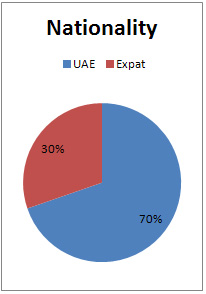
Out of the respondents, it is observed
that 70% of them belong to UAE nations
and 30% are expatriates from foreign
nations working in UAE. Thus, the
responses include data from both UAE
nationals as well as from foreign
nationals thus avoiding the data risk
of nationality or partiality.
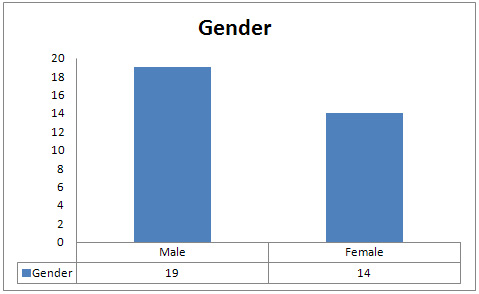
On basis of gender, the data responses
are mixed both from male as well as
from female. Out of the sample data
of 33, 19 are from male and 14 are
from female thus distributing the
responses evenly avoiding the data
partiality on basis of gender.

Similarly, on basis of age group as
well, the data is distributed evenly
among all working class age groups
above 20 thus avoiding the risk of
partiality on basis of age. The distribution
of data on basis of age group is as
depicted above.
Thus, three major key demographic
factors nationality, gender and age
group are considered to verify and
avoid data partiality on basis of
these factors.
Further, the responses on each question
are recorded and are summarised as
per the factor corresponding to the
question. These summed up variables
are sent through t-test for testing
the hypothesis framed above in 1.3.
The hypothesis framed is as listed
below:
HYPOTHESIS
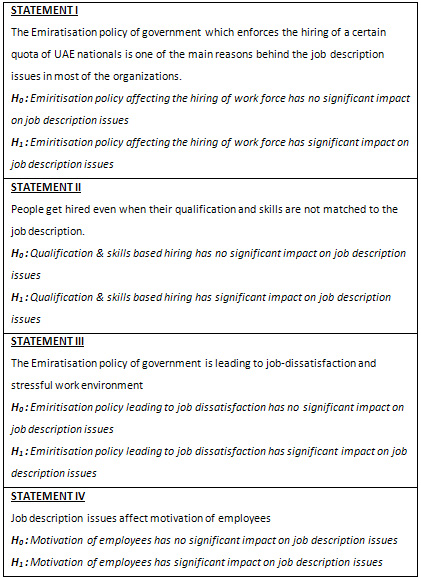
MS Excel is used as a tool for performing
the t-tests for testing the hypothesis
framed above. The data was summed
into factors and analysed in Excel,
with the following steps needing to
be performed.
• Click on Data tab -> data
analysis -> t-test for sample means
• Select variable 1 range as
the input responses on the job description
issue related responses and are same
for all other variables as this is
the main variable on which significant
impact needs to be tested.
• Select variable 2 range as
the input responses on the factor
being considered every time.
• Select the confidence level
of 95% and check mark labels if the
first data of the selected columns
is the label of the column
• Choose the output range where
to display the results and click ok
• The t- statistics results are
as discussed below:

The above table shows that the t-statistic
value is 0.42 which is less than the
t-critical value of 1.69 at 95% confidence
level and also the p-value is 0.34
greater than the alpha value of 0.05
indicating that the null hypothesis
is not rejected or accepted. Thus,
the Emiritisation policy based hiring
has no significant impact on the job
description issues. That is, the Emiratisation
policy of government which enforces
the hiring of a certain quota of UAE
nationals is not one of the main reasons
behind the job description issues
in most of the organizations as per
statistic results above. This is a
contradictory result but is quite
possible as there are other factors
based on Emiritisation policy which
might have significant impact leading
to job description issues. This is
also discussed in the literature review
for the support of secondary data
results and observations.
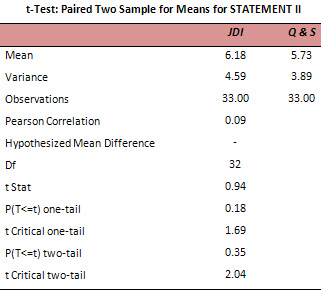
From the table above it can be noted
that the t-statistic value is less
than the t-critical at 95% confidence
level and the p-value is greater than
the alpha=0.05, thus the null hypothesis
is accepted stating that the qualification
& skills based hiring has no significant
impact on the job description issue.
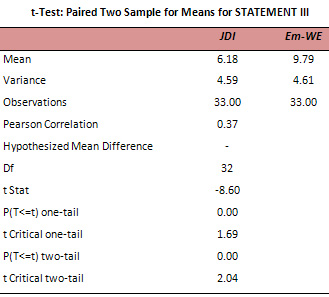
The table above shows that the t-statistic
value is -8.6 and thus falls out side
the critical region of normal distribution
at 95% confidence level and also the
p-value is much less than the alpha
value =0.05 and thus the null hypothesis
is rejected.
Thus, alternative hypothesis is accepted
which states that the Emiritisation
policy leading to job dissatisfaction
has significant impact on job description
issues. That is, The Emiratisation
policy of government is leading to
job-dissatisfaction and stressful
work environment further contributing
to the job description related issues.
Thus, Emiritisation policy is causing
job description issues but through
job dissatisfaction and stress environment
not because of quota reservation to
UAE nationals.

Motivation for employees includes
additional benefits that the company
provide to the employees like additional
earned leave where employees are paid
even on obtaining leave, rewards and
awards on sincerity, timely attendance
and so on which would further show
impact on job satisfaction and job
performance. This factor also corresponds
to the boost up of employees to perform
well towards the company's objectives
and profit and thus job description
issues and motivation factor could
be interlinked but the table above
shows that the null hypothesis is
accepted and thus there is no significant
relationship between the job description
issues and motivation of employees
as per statistics. The t- statistical
value is less than the t-critical
value and p-value is higher than the
alpha value at 95% confidence level
indicating that the null hypothesis
is accepted.
Thus as per statistical analysis from
the data collected through online
survey conducted based on the questionnaire
in the appendix, Emiritisation policy
leading to job dissatisfaction and
stressful environment is the major
contributor towards job description
issues and other factors including
qualification & skills related;
quota based hiring and motivation
does not have significant impact on
the job description related issues.
Conclusion
The research study aimed at understanding
the job description related issues
in the United Arab Emirates nations,
factors responsible for job description
issues and their significance along
with the study on Emiritisation policy
has been successfully completed as
discussed in the above sections. The
entire details above regarding job
descriptions, factors causing job
description related issues which includes
Emiritisation policy, qualifications
& skills, motivation are discussed
in detail through supporting literature
and previous research works. Further,
hypothesis is framed so as to analyse
the impact of these factors in causing
job description related issues. It
is understood from the statistical
analysis that the Emiritisation policy
implemented by the government is causing
job dissatisfaction and is creating
stressful work environment at a significant
level compared to all other factors.
Further the research study can be
more accurately conducted with the
help of correlation and regression
analysis which helps in establishing
any linear relationship among the
factors and the job description issues.
This could be the future scope for
the existing research study.
Thus, it can be concluded that the
Emiritisation policy leads to job
dissatisfaction and a stressful work
environment leads to job description
related issues in the work place.
Bibliography
Al-Ali, J. (July 2007). Emiratisation:
drawing UAE nationals into their surging
economy. International Journal of
Sociology and Social Policy , 365-367.
Almazroui, A. (2013, 5 18). Emiratisation
won't work if people don't want to
learn. Retrieved 11 15, 2015, from
The National: http://www.thenational.ae/thenationalconversation/comment/emiratisation-wont-work-if-people-dont-want-to-learn
Al-Waqfi, M., & Forstenlechner,
I. (2010). Stereotyping of citizens
in an expatriate-dominated labour
market. Employee Relations , 364-381.
Amos, T., Ristow, A., Pearse, N.,
& Ristow, L. (2009). Human Resource
Management. Juta and Company Ltd.
Baik, E. A. (2010, 2 25). Emiratisation
rises 3.3% across banking sector.
Retrieved 11 17, 2013, from Emirates
24/7: http://www.emirates247.com/eb247/banking-finance/banking/emiratisation-rises-3-3-across-banking-sector-2010-02-25-1.37216
Emirati graduates choose government
over private sector jobs. (2013, 3
11). Retrieved 11 17, 2013, from Gulf
Talent: http://www.gulftalent.com/articles/2013/03/emirati-graduates-choose-government-over-private-sector-jobs/
Forstenlechner, I. (2008). Workforce
nationalization in the UAE: image
versus integration. Education, Business
and Society:Contemporary Middle Eastern
Issues , 82-90.
Gary, D. (2011). Human Resource Management.
Pearson Education India.
H.McColl, V. J. (n.d.). Hypothesis
Testing. Retrieved Nov 2013, from
Statistics Glossary: http://www.stats.gla.ac.uk/steps/glossary/hypothesis_testing.html#hypothtest
How can Emiratisation affect your
business? (n.d.). Retrieved 11 15,
2013, from Path Finder Buzz: http://pathfinderbuzz.com/how-can-emiratisation-affect-your-business/
Khan, M. N. (2012, 11 7). Statistics
suggest sorry state of Emiratisation
in private sector. Retrieved 11 17,
2013, from The National: http://www.thenational.ae/news/uae-news/statistics-suggest-sorry-state-of-emiratisation-in-private-sector?utm_source=rss&utm_medium=UAE%20news&utm_campaign=feed
Price, A. (2011). Human Resource Management.
Cengage Learning.
Randhawa, G. (2007). Human Resource
Management. Atlantic Publishers &
Dist.
Salem, O. (2010, 12 11). Firms face
big fines for 'ghost emiratisation'.
Retrieved 11 17, 2013, from The National:
www.thenational.ae/news/uae-news/firms-face-big-fines-for-ghost-emiratisation
Salem, O. (2013, 10 15). FNC advocates
Emiratisation quotas for the private
sector. Retrieved 11 17, 2013, from
The National: http://www.thenational.ae/uae/fnc/fnc-advocates-emiratisation-quotas-for-the-private-sector
Shaheen, K. (2010, 1 27). Government
attacks Emiratisation laggards. Retrieved
11 17, 2013, from The National: www.thenational.ae/news/uae-news/politics/government-attacks-emiratisation-laggards
Sims, R. R. (2007). Human Resource
Management: Contemporary Issues, Challenges,
and Opportunities. IAP.
Thompson, M. A. (2011, 11 26). Going
Global Employment Outlook: United
Arab Emirates. Retrieved 11 15, 2013,
from GoinGlobal: http://www.goinglobal.com/articles/987/
UAE Citizens Are a Tiny Fraction .
(2010, 5 21). Retrieved 11 17, 2013,
from The Daily Stat: http://web.hbr.org/email/archive/dailystat.php?date=052110
|